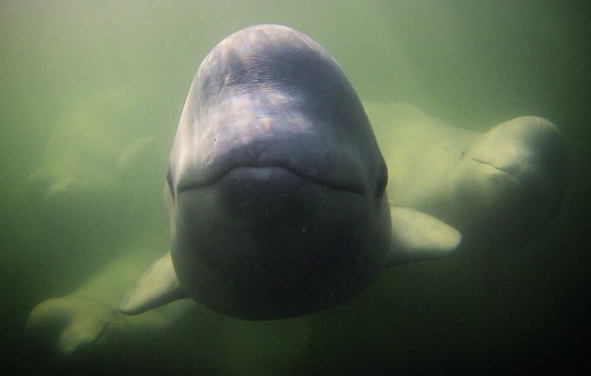Churchill is a frontier town perched on the frozen edge of Canada’s Hudson Bay. Famous for being the “Polar Bear Capital of the World”, the area is also known for the massive population of beluga whales that mass in the bay every summer.
“And don’t kayak too near the port or we’ll have the Ottawa Terrorism Police on us.” It’s another out-of-the-blue comment from our lanky kayak instructor, Tress, but out-of-the-blue seems just right on a warm day with cloudless skies arcing over this Canadian stretch of the 58th parallel.
I’m part of a small group gathered in a dockyard on the edge of the Churchill River, Manitoba. We’ve been fortunate with today’s weather as, up until now, it’s been – to put it mildly – unsettled. Vast thunderstorms have swept the expansive Hudson Bay all week – a remarkable sight with northern Manitoba’s cinematic skyscape apparently roomy enough to host several hurricanes simultaneously.
The dramatic sense of scale extends to the pests that wander into frontier town Churchill. That the rough-around-the-edges settlement is famous as the “Polar Bear Capital of the World” offers a hint as to what the locals sometimes have to deal with when they hear a noise on the porch. The town’s rubbish dump had to be enclosed after it attracted too many of the world’s largest land carnivores, and on Halloween night there’s a ban on children dressing as ghosts… for safety’s sake.
However, Churchill also has another alias: “Beluga Capital of the World”. And, despite the received wisdom about being in the water near a white whale, that’s exactly what Tress is preparing us for today. Fortunately belugas defy Manitoba’s laws of scale and are roughly the length of the sea kayaks that await our group on the riverbank. Despite the whale’s small size, their pods are easy to spot as you fly over the bay; the fluorescent white mammals glow beneath the water’s textured jade skin. Nearly 60,000 of the whales pour into the western half of the bay every summer to breed and put on weight for the winter, and about half of those congregate in the estuary that we are about to paddle into.
Ensconced in our kayaks, we slip into the river’s calm, cold waters. Tress drives a zodiac ahead of us. We follow him out into the middle of the estuary, where the river widens before emptying into the saltwater bay. The sunlight ripples off of the water while my slim kayak rocks gently, buffeted by tiny waves. I have been assured that beluga whales are very friendly, gentle creatures. Playful. And I remember that video of the playful humpback breaching and landing on a two-person canoe off of California. And I think that even a small whale is a fairly large thing.
After about a minute of paddling, Tress signals that we’re where we want to be. Everyone begins glancing around. It isn’t long before I spot one, and another, and then three more. They are everywhere, their pale finless backs rising like rhythmic pistons as they drive through the water. By chance or by design they all appear to be avoiding our group, maintaining a good twenty feet between whale and kayak-bound gawker.
Immediately we give chase, each canoe pursuing the nearest whale and scattering our group. But we’re constrained by buoys to stay in a particular area, while the whales aren’t. Panting with the effort, I watch my mammalian quarry disappear beyond reach downriver. Playful, indeed. Tress cruises up to remind me of the boundaries, before adding, “Just stay still. They come to you.”
I paddle back into the middle and wait. There are whoops as members of our group have exciting interactions with whales while I bob like a piece of forgotten driftwood. Gangs of whales three or four strong crisscross our area. Finally I notice two coming straight for me at a fair clip. One is bright white and one is darker, therefore younger. When they’re about ten feet out I brace for impact. They dive smoothly… and disappear. The water around the kayak is calm. Then bubbles tap the boat from below.
They’re beneath me.
I cautiously peer over my shoulder. My heart skips. Up through the bottle brown water hovers a ghostly smiling face. I wave foolishly, nearly losing my paddle. The mature whale is floating upside down about a foot beneath my kayak. It’s clear why they’re nicknamed “melonheads”; their large round skulls house an echolocation organ that aids the arctic mammal in finding blowholes when beneath sheet ice.
I paddle away slowly, to see what it’ll do. Was that a nudge on the stern? I paddle faster, glancing back to see the two whales in pursuit. It’s exhilarating. But as abruptly as they arrive, they disappear. Fortunately, there’s more. Plenty more. The next hour is spent experimenting with how to best interact with the whales: splashing the water with the paddle, humming deeply, tapping the side of the canoe. Emboldened, I manoeuvre the kayak into the path of three mature whales and receive a purposeful splash from a tail as they dive beneath my kayak and continue towards the rivermouth. There are endless futile attempts at selfies.
Time up, we regain the land. Someone has recorded an underwater GoPro video, capturing the whales’ clicks and whistles that have earned them the name “sea canaries”. Someone mentions that you can swim with belugas at a lodge further north, and we’re all extremely enthusiastic. I ask Tress whether he prefers the local polar bears or the belugas. “Definitely the whales. It’s beyond interactive. On the west coast of Vancouver Island, if you see a whale 300 yards away everyone’s freaking out. Here they’re trying to flip over my clients, so it’s a little bit different, right?”
Right.
Chris Allsop was a guest of Sea North Tours (www.seanorthtours.com). Kayaking with belugas costs $160 pp for two hours on the water.


